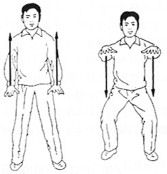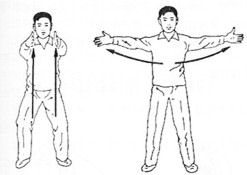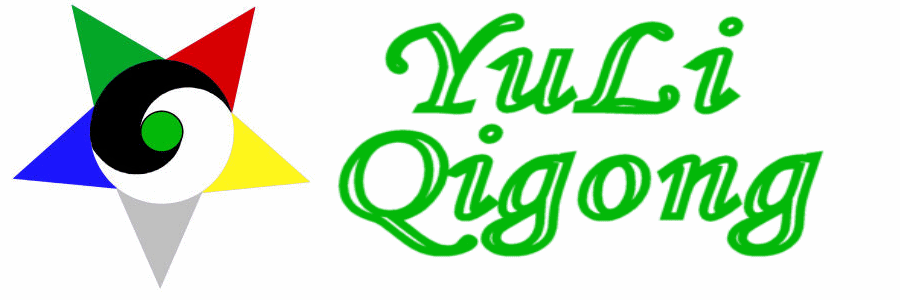The Wuji Qigong Short set.
Wujigong Post Standing:
Stand normally, relaxed. Place your feet shoulder width apart and parallel (outside heels are shoulder width, you can measure your shoulders (use the widest point at the middle deltoid muscle) and keep a small stick of the correct length on the floor). This “parallel” is with the outside edges of your feet parallel, not the inside, your toes should then be pointing forwards. The balance of your weight should be about 55% / 45% between the balls of your foot to your heel, just enough so you feel a slight forward sense. Slightly “grip the ground” with your toes.
The kua is the area from the thickest part of one thigh (inside of the thigh), up through the genitals, to the same point on the other thigh. Slightly bend your knees, and tuck your lower pelvis forward just a bit, as if you are thinking about sitting down. This allows you to relax the “kua” and keep it rounded. Remember to maintain the curl of your toes, you are being song (relaxed). Drop your shoulders and relax the arms. Keep your head straight with the chin just in enough so that the crown of your head, the hole of your ear, the mid point of the shoulders, hips and ankles are in line. As if you are being suspended from a string attached to the crown of your head. The crown of the head is the baihui or DU20 point. Put your tongue tip lightly on your palate, just behind your teeth, you should feel a little dip or ridge. Your middle finger should be touching your leg on the Gallbladder 31 point. This is on the outside of your leg in the indentation between muscles. Breathe abdominally.
One of your goals is to make abdominal breathing your normal breath. Now, imagine or visualize you are in a warm shower, or, for you outdoor types, in a warm spring rain. The water runs over your body, washing away tension and stress. As you continue to breathe, imaging this water is able to run through your body as well, washing away more stress and tension. It is also washing away stale Qi, and washing past any places Qi is blocked to open up the flow. The stale Qi washes down though your body and out the kidney 1 or bubbling well point. Repeat the breaths 9 times, up to 38 times until you are relaxed (song); your breathing should be slowing down as you relax. You can do this same exercise seated, but with the hands palm up on the top of your thighs. It is a great way to reduce stress, relax and lower your blood pressure. This is a zhangzhuan or post standing gong.
Wujigong Buddha’s Attendant:
 Now move your hands until they are on the front of your thighs, palms toward the rear. Bend your knees slightly more, begin a slow inhale, as your arms begin to float up to shoulder height and your knees extent slightly. Do not lock your knees. Imagine you are in thick water or warm honey, so that as your arms rise, your hands naturally drop so that your fingers point down. Elbows stay pointing down; do not swing the elbows out to the sides as the arms rise up. As you inhale and raise your arms, you are expanding. Your arms should be just away from the body, so the armpits are not compressed. When your hands reach shoulder height, they are hanging naturally, the fingers should be pointing at the lower dantien. Imagine you are sucking in pure earth Qi in though your Kidney 1 points on your feet as your hands rise.
Now move your hands until they are on the front of your thighs, palms toward the rear. Bend your knees slightly more, begin a slow inhale, as your arms begin to float up to shoulder height and your knees extent slightly. Do not lock your knees. Imagine you are in thick water or warm honey, so that as your arms rise, your hands naturally drop so that your fingers point down. Elbows stay pointing down; do not swing the elbows out to the sides as the arms rise up. As you inhale and raise your arms, you are expanding. Your arms should be just away from the body, so the armpits are not compressed. When your hands reach shoulder height, they are hanging naturally, the fingers should be pointing at the lower dantien. Imagine you are sucking in pure earth Qi in though your Kidney 1 points on your feet as your hands rise.
As you lower your arms, exhale through your mouth (tongue still up), with stale Qi leaving your mouth and out the PC 8 (laogong) points on the palms. As your hands drop, keep your elbows down, leading the hands, and in this thick honey, your hands (wrists) naturally bend so the fingers point up. You should stop the exhalation when your hands touch your body, and the Qi flow stops as the fingers drop to touch your thighs. When your fingers touch your thighs, pause for a second or two, then begin to inhale. What you have done is create a Qi pump. The abdomen acts like a bellows, when it expands Qi is pulled in through the foot points and mouth, and when it contracts bad Qi is expelled through the palm points and mouth. As the air and the Qi enters your body, think of a balloon under your skin, expanding with the incoming air and Qi, and let the pressure help lift your arms. Don’t think about lifting your arms; just know they will reach your shoulders.
Now, as the Qi enters your feet, not only does it flow up the meridians, it flows up inside the body, spiraling as it moves. Think about Qi and strength (power) spiraling from your right foot to your right hand traveling up the meridians and in the tissues that surround your muscles. Then think about it spiraling from your left foot to your left hand, then both feet to both hands. Now imagine it flows across your body from one foot to the opposite hand. Then Qi flows from both feet to one hand and as it spirals from the shoulder out to your hand, you can feel great strength, so that your rising hand could lift a hundred pounds. Repeat this up to 38 times, depending on your health and condition, do not over stress.
Wuji Qigong Butterfly Wings:
 This is a continuation of the Wujigong Buddha's Attendant. I call it Butterfly Wings since you can imagine the strength generated by the tiny body of a butterfly to flap those big wings. Not only the strength but also the spiral motion needed to move forward and fly. If the wings only went up and down, the butterfly would go nowhere.
This is a continuation of the Wujigong Buddha's Attendant. I call it Butterfly Wings since you can imagine the strength generated by the tiny body of a butterfly to flap those big wings. Not only the strength but also the spiral motion needed to move forward and fly. If the wings only went up and down, the butterfly would go nowhere.
Begin by raising your hands on the inhale, just as before, but now, when the hands reach chest high, they rotate so that the fingers point to each other, and the arms flow out to the side, rotating so they are palm up when fully extended; just past your shoulders. You do not breathe into the chest, but the chest naturally expands (opens) as the arms move past your mid-line (front to back). Elbows still point down. As the arms go back, the hands rotate again, so that as the arms come forward the palms point together. As your hands reach straight in front of you, they rotate again to face down, and the hands sink towards your Dan Tien. You exhale from the time your hands reach their most rearward point, until they touch your DanTien. As you exhale the balloon acts like the air is being sucked out and it contracts, hollowing the chest and pulling the hands towards the center and then down. Your hands are gathering Qi and bringing it to your Dan Tien. The power is still coming from the ground; the Ming Men point in the small of your back is where it concentrates to power the arms as the chest opens and the back closes.
On your last cycle, when the hands go back behind your shoulders for the last time; the hands rise to overhead, palms facing your head. They collect an armful of golden (Sun) Qi and as they move down, fingers almost touching, the Qi is gently pressed into the baihui (DU20) point at the top of the skull, then into the third eye, then into the eyes and Bladder 1 points, into the nose and mouth and is drawn down to the dantien where it is stored.
Wuji Qigong Crane Form:Start with your legs about ½ shoulder width apart. Place both hands on the front of your thighs. As you inhale, raise your right knee and your right hand. The hand rotates slowly so that when it is shoulder high, it is palm up, then the fingers turn to the right, so that when your arm is extended the palm points up and the fingers point to the rear. Your upper leg is parallel to the floor. When you exhale, the foot slowly drops and the hand and arm fall vertically, elbow leading until the palm reaches your thigh. You are drawing Qi from the ground, spiraling up to your hand where it mixes with the Qi from the air and you draw both in through the Laogong point. It travels down your arm to your Dantien.
Your weight then shifts to the left leg and you repeat the sequence. Inhale up and exhale down. Repeat up to 18 times per side.
Now begin the same way, but raise the left hand when the right leg rises, and the right hand moves down and the arm straightens, but the fingers point forwards. As the left hand drops, the right hand begins to rise, when the right foot lands, the weight shifts and the left foot rises. Your tongue still is kept on the palate and the breathing is abdominal, one breath per up / down cycle. The knee is raised high and if you can, bring it almost to the chest. The toes of the foot point down when the knee is raised up.
Wujigong Closing:
Click your teeth together 36 times, allowing the saliva to collect in your mouth, and then swallow it in three sections. As you swallow feel Qi flow down with the saliva, continuing to the Dantien.
Now that you have a supply of good Qi, you want to circulate it to your central organs. Place your hands (one on top of the other) over the dantien (about 2 inches below the navel), with the Laogong (PC 8) points of each hand in line. I have heard that if you are male the left hand goes over the right and if female, the opposite. Coming from a martial background, where you need to be able to do anything with either hand, I don’t see this is important. You can alternate hands each time you practice.
Begin a spiral from small to large, down to the right, then up and over to the left side, down again etc. so that you complete 9 turns until your hands reach the solar plexus at the top, and the Kidney 11 point at the bottom. Then spiral back in to your lower Dan Tien. Breathe abdominally and slowly. Finish at the end of an exhale, and then relax hands to sides.
